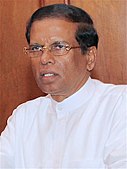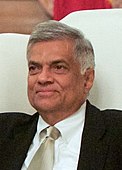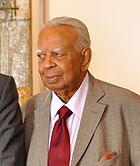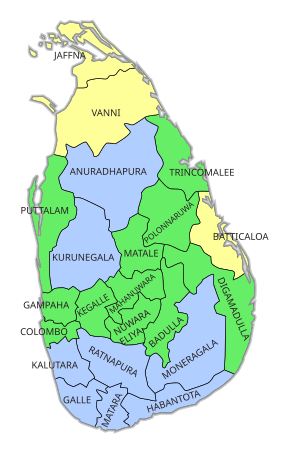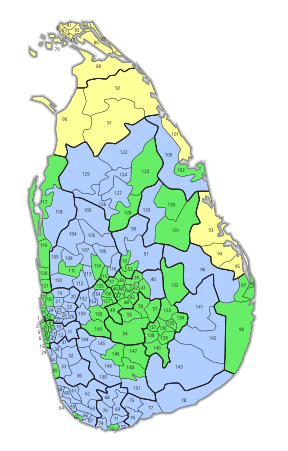General election in Sri Lanka 2015

Government (107): United National Front for Good Governance (UNFGG) (106) Sri Lanka Muslim Congress (SLMC) (1) Selective support of the government (22): Tamil National Alliance (TNA) ( 16) Janatha Vimukthi Peramuna (JVP) (6) Opposition (96): United People's Freedom Alliance (UPFA) (95) Eelam People's Democratic Party (EPDP) (1)
The 2015 general election in Sri Lanka took place on August 17, 2015. It was an early election, as the six-year term of the Sri Lankan parliament, elected in 2010, would have lasted until April 2016. The United National Party (UNP) of the incumbent Prime Minister Ranil Wickremesinghe won 106 of 225 seats in parliament, making it the strongest force, while Mahinda Rajapaksa 's United People's Freedom Alliance (UPFA) suffered a severe defeat. The parliamentary backing of the Wickremesinghe government, which had undertaken a comprehensive package of domestic political reforms, was thus significantly strengthened.
prehistory
The last parliamentary election in Sri Lanka took place in April 2010 and was won by the UPFA , the party association of President Mahinda Rajapaksa, who had been re-elected in the same year . Rajapaksa was at a popularity high at that time, as he had succeeded under his presidency in defeating the rebellious Tamil Tigers decisively militarily and thus ending the civil war in Sri Lanka that had been going on for decades . During Rajapaksa's ten-year tenure as president from 2005 to 2015, criticism of his administration grew. He was accused of nepotism and an arrogant, autocratic style of government. Numerous offices in the economy and in the state apparatus were occupied by the influential family clan of the Rajapaksas. On the international side, a climate of political intimidation and recurring human rights violations, especially against the Tamil minority in the country, were expressed with concern . The human rights violations during the civil war were also not dealt with legally. According to UN estimates, more than 40,000 Tamil civilians were killed by government forces in the final phase of the civil war. In October 2014, Rajapaksa announced early presidential elections for January 2015, in which he ran again as a candidate. Previously, at his instigation, the constitution had been changed to allow him a third term. In the opinion of political observers, the president had noticed his steady gradual decline in popularity and wanted to hold new elections in good time at a time that seemed favorable to him, as long as he believed a majority was secure, as long as no convincing opposition candidate was in sight.
Here, however, Rajapaksa had miscalculated. A month after the election announcement, his own health minister , Maithripala Sirisena , surprisingly declared his candidacy against Rajapaksa. Sirisena resigned from his ministerial office, resigned from the UPFA and formed an electoral alliance with various opponents of Rajapaksa. In the presidential election on January 8, 2015 , Sirisena triumphed over Rajapaksa by a narrow majority and was sworn in as the new President of Sri Lanka one day later.
The majority in the Sri Lankan parliament remained the same despite the outcome of the presidential election. The UPFA continued to have a majority here. Within the UPFA there was a smaller parliamentary group that supported Sirisena and had also supported the election. The majority, however, consisted of the followers of Rajapaksa. After the election, Sirisena was re-admitted to the Sri Lanka Freedom Party (SLFP), the main party of the UPFA party alliance, as otherwise the pro-Sirisena faction would have threatened to split off. In a kind of 180 ° U-turn, the SLFP elected him chairman on January 16, 2015 after Rajapaksa had resigned from this office. On March 14, 2015, Sirisena also became leader of the UPFA party alliance. He benefited from a regulation that Rajapaksa had introduced to force his predecessor Chandrika Kumaratunga out of leadership: namely that the incumbent president, if he was a UPFA member, should automatically be entitled to the leadership position of the UPFA.
Even before the election, Sirisena had promised a 100-day program that included various reforms to democratize Sri Lanka. Among other things, a change in the right to vote in parliament was planned. The number of MPs was to be increased from 225 to 250, with 196 elected in individual constituencies by relative majority voting, and the rest to be determined via a nationwide list according to the percentage of the votes cast by the parties. A constitutional amendment (20th amendment to the constitution) would have been necessary for this, but there was no two-thirds majority in parliament. The Prime Minister Ranil Wickremesinghe , newly appointed by President Sirisena, had difficulties implementing his government program in parliament. After Sirisena announced his intention to hold new parliamentary elections in the foreseeable future shortly after his election, he had parliament dissolved on July 26, 2015. New elections were scheduled for August 17, 2015.
- Sri Lankan politicians
Ranil Wickremesinghe , UNP party leader and Prime Minister since January 9, 2015
R. Sampanthan
(TNA)
Election mode
The election is based on proportional representation . The country is divided into 22 electoral districts , which are largely identical to the administrative districts of Sri Lanka . In each constituency a certain number of representatives are elected according to the proportional representation according to the share of the votes of the respective parties. For example, the Colombo constituency elects a total of 19 MPs in the current election. The voters have the opportunity to change the order on the ballot so that the candidates in the first places on the party list do not necessarily win the race. A total of 196 MPs are elected at constituency level. 29 more MPs are chosen based on the nationwide performance of the parties. The total number of MPs is 225.
Election campaign
On July 6, 2015, the Sri Lankan Electoral Commission published a list of the 64 registered political parties that are eligible to vote.
Two major party alliances faced each other in the election: on the one hand the United People's Freedom Alliance (UPFA), in which the Sri Lanka Freedom Party (SLFP) formed the largest party, and on the other hand that of July 12th The United National Front for Good Governance (UNFGG) was newly formed in 2015 . The UNFGG, led by the United National Party (UNP), the party of Prime Minister Ranil Wickremesinghe, also included the Sri Lanka Muslim Congress (SLMC), the Tamil Progressive Alliance (TPA) and the Sinhalese Buddhist Jathika Hela Urumaya (JHU) allied. UPFA and UNFGG nominated candidates in all constituencies of Sri Lanka.
The radical socialist-nationalist Janatha Vimukthi Peramuna (JVP) also ran in all constituencies with its own candidates. The Tamil National Alliance (TNA), an alliance of Tamil parties, only nominated candidates in five northern and eastern constituencies. The Democratic Party of former army general and presidential candidates from 2010 Sarath Fonseka ran separately in all constituencies except Jaffna, Vanni and Polonnaruwa. The nationalist-Buddhist Bodu Bala Sena ran together with the Eksath Lanka Maha Sabha Party (ELMSP) as Bodu Jana Peramuna (BJP, “Buddhist Popular Front”) in 15 constituencies.
Former President Mahinda Rajapaksa announced in early July 2015 his intention to run for the UPFA in the election. President Sirisena initially expressed his disapproval, but then had to bow to pressure from the Rajapaksa supporters in the UPFA / SPLF, so that Rajapaksa and some of his shop stewards were nominated as a candidate for the UPFA. On July 21, 2015, Sirisena stated in an address to SLFP officials that he was aiming for a government led by the SLFP, in which both ex-President Rajapaksa and ex-President Chandrika Kumaratunga were members. Both are known to be enemies. The President found himself in a certain bind. On the one hand, he was expected to have a certain non-partisan neutrality; on the other hand, as chairman of the SLFP and UPFA, he was bound by party politics and, thirdly, he wanted to prevent his opponent Rajapaksa from making a political comeback , for example in the role of prime minister, since with Rajapaksa as prime minister that of Sirisena political reforms would not be feasible.
Various opposition parties such as the JVP accused Sirisena of electoral fraud because of this tactic. Many supporters of President Sirisena from the SLFP and UPFA, for whom Rajapaksa was a red rag, then declared their support for the UNP. During the election campaign, Sri Lankan media reported that Sirisena had sent a letter to Rajapaksa, in which the latter categorically ruled out the appointment of him as prime minister. When asked about this, Rajapaksa said on August 13, 2015 that he had not yet received such a letter.
As already known from previous elections, the election campaign was overshadowed by numerous violent clashes. The Center for Monitoring Election Violence (CMEV), a non-governmental organization , reported 143 major incidents and 667 minor incidents from July 13 to August 13, 2015. Firearms were involved in 12 incidents. By August 15, 2015, four people were killed. Compared to previous elections, there were significantly fewer incidents overall. The actual election day was also much more peaceful than in previous elections, despite hundreds of incidents recorded by CMEV observers, most of which were attempts to influence or intimidate voters. Observers even spoke of the "fairest and most peaceful election in 20 years".
Results
Overall result
The nationwide voter turnout was 77.66% (11,684,098 voters out of 15,044,490 eligible voters) and was thus significantly higher than in the last election in 2010 (61.26% at the time). The turnout varied from region to region and was lowest in the Northern Province. However, the differences were nowhere near as great as in previous elections, in which, in some cases, large parts of the Tamil population in the northern province did not take part in the election.
| Party / electoral alliance | Abbreviation | be right | % | Seats | |||
|---|---|---|---|---|---|---|---|
| nationwide | Constituencies | total | |||||
| United National Front for Good Governance | UNFGG | 5,098,916 | 45.66 | 13 | 93 | 106 | |
| United People's Freedom Alliance | UPFA | 4,732,664 | 42.38 | 12 | 83 | 95 | |
| Janatha Vimukthi Peramuna | JVP | 543.944 | 4.87 | 2 | 4th | 6th | |
| Tamil National Alliance | TNA | 515.963 | 4.62 | 2 | 14th | 16 | |
| Sri Lanka Muslim Congress | SLMC | 44.193 | 0.40 | 0 | 1 | 1 | |
| Eelam People's Democratic Party | EPDP | 33,481 | 0.30 | 0 | 1 | 1 | |
| Democratic Party | DP | 28,587 | 0.26 | 0 | 1 | 1 | |
| All the rest together | 169.227 | 1.52 | 0 | 0 | 0 | ||
| Total valid votes | 11,166,991 | 100.0 | 29 | 196 | 225 | ||
| Invalid or empty ballot papers (as a percentage of those submitted) |
517,123 (4.4%) |
||||||
| Total votes cast (turnout) |
11,684,098 (77.66%) |
||||||
| Registered voters | 15,044,490 (100.0%) |
||||||
The UNP or UNFGG won a total of 106 parliamentary seats (47.1%) and thus just missed an absolute majority. However, as before, the UNP could count on parliamentary support from the JVP and the SLMC. The TNA was also fundamentally positive about Prime Minister Wickremesinghe's reform agenda. There was also a “reform faction” in the UPFA / SLFP that President Sirisena wanted to support.
Results by constituency
| Constituency | Valid votes |
Seats | UNP | UPFA | TNA | JVP | Other | Wahlbe- pation |
|||||
|---|---|---|---|---|---|---|---|---|---|---|---|---|---|
| % | Seats | % | Seats | % | Seats | % | Seats | % | Seats | ||||
| Colombo | 1,208,899 | 19th | 53.00 | 11 | 39.21 | 7th | - | 0 | 6.73 | 1 | 1.06 | 0 | 78.93 |
| Gampaha | 1,224,401 | 18th | 47.13 | 9 | 44.92 | 8th | - | 0 | 7.18 | 1 | 0.77 | 0 | 78.21 |
| Kalutara | 697.635 | 10 | 44.47 | 4th | 48.56 | 5 | - | 0 | 5.52 | 1 | 1.45 | 0 | 80.13 |
| Mahanuwara | 793.100 | 12 | 55.57 | 7th | 38.98 | 5 | - | 0 | - | 0 | 5.45 | 0 | 79.13 |
| Matale | 277.380 | 5 | 49.84 | 3 | 45.54 | 2 | - | 0 | 3.95 | 0 | 0.67 | 0 | 78.73 |
| Nuwara Eliya | 387,946 | 8th | 59.01 | 7th | 37.98 | 3 | - | 0 | 1.44 | 0 | 1.57 | 0 | 78.77 |
| bile | 624.211 | 10 | 42.48 | 4th | 50.07 | 6th | - | 0 | 6.05 | 0 | 1.4 | 0 | 78.00 |
| Matara | 477.717 | 8th | 52.44 | 5 | 39.08 | 3 | - | 0 | 7.38 | 0 | 1.1 | 0 | 78.61 |
| Hambantota | 365,829 | 7th | 35.65 | 3 | 53.84 | 4th | - | 0 | 9.98 | 1 | 0.53 | 0 | 81.20 |
| Jaffna | 300,309 | 7th | 6.67 | 1 | 5.76 | 0 | 69.12 | 5 | 0.08 | 0 | 18.37 | 1 | 61.56 |
| Vanni | 164,775 | 6th | 23.98 | 1 | 12.72 | 1 | 54.55 | 4th | 0.53 | 0 | 11.69 | 0 | 71.89 |
| Batticaloa | 238,846 | 5 | 13.55 | 1 | 13.49 | 0 | 53.25 | 3 | 0.03 | 0 | 19.71 | 1 | 69.11 |
| Digamadulla | 326.195 | 7th | 46.30 | 4th | 27.39 | 2 | 13.92 | 1 | 1.65 | 0 | 10.74 | 0 | 73.99 |
| Trincomalee | 180.396 | 4th | 46.36 | 2 | 21.32 | 1 | 25.44 | 1 | 1.42 | 0 | 5.46 | 0 | 74.34 |
| Kurunegala | 962.423 | 15th | 45.85 | 7th | 49.26 | 8th | - | 0 | 4.27 | 0 | 0.62 | 0 | 79.63 |
| Puttalam | 357.508 | 8th | 50.40 | 5 | 42.83 | 3 | - | 0 | 3.42 | 0 | 3.35 | 0 | 68.83 |
| Anuradhapura | 475.383 | 9 | 44.82 | 4th | 48.35 | 5 | - | 0 | 6.04 | 0 | 0.79 | 0 | 79.13 |
| Polonnauwa | 236,462 | 5 | 50.26 | 3 | 43.63 | 2 | - | 0 | 5.71 | 0 | 0.40 | 0 | 79.81 |
| Badulla | 472,682 | 8th | 54.76 | 5 | 37.97 | 3 | - | 0 | 4.54 | 0 | 2.73 | 0 | 80.07 |
| Monaragala | 262,988 | 5 | 52.53 | 3 | 41.97 | 2 | - | 0 | 5.18 | 0 | 0.32 | 0 | 80.13 |
| Ratnapura | 632.196 | 11 | 44.94 | 4th | 51.19 | 6th | - | 0 | 3.40 | 0 | 0.47 | 0 | 80.88 |
| Kegalle | 499,694 | 9 | 49.52 | 5 | 45.47 | 4th | - | 0 | 3.64 | 0 | 1.37 | 0 | 79.81 |
| Overall result | 11,166,991 | 196 | 45.66 | 93 | 42.38 | 83 | 4.62 | 14th | 4.87 | 4th | 2.48 | 2 | 77.66 |
- ↑ of which 3.87% for the SLMC
- ↑ a b of which 10.07% and a mandate for the Eelam People's Democratic Party
- ↑ of which 3.47% for the SLMC
- ↑ a b thereof 16.11% and a mandate for the Sri Lanka Muslim Congress
- ↑ of which 10.15% for the All Ceylon Makkal Congress
Voting cards
After the election
After the preliminary election results became known, Rajapaksa admitted on August 18, 2015 that he had missed his election target. He "lost a good fight" and "his dream of becoming prime minister has evaporated". In an analysis of the outcome of the election, the Sri Lankan political scientist Jayadeva Uyangoda suspected that the election result was partly due to the fact that the UPFA relied solely on the Sinhalese voter potential and the old political style and did not bring any new ideas on how to shape the future. In the predominantly Sinhalese areas, the UPFA had won high shares of the vote, but fared significantly worse in the areas with a mixed population or in the areas with national or religious minorities. The majority of Sri Lanka's people want the rule of law and not the rule of a strong man, said the director of the National Peace Council in Colombo, Jehan Perera. The election result was also a victory for President Maithripala Sirisena, who could now continue his reform program. However, a two-thirds majority in parliament is required for any constitutional amendments, which can only be obtained in a compromise with the opposition.
Individual evidence
- ↑ a b c Parliamentary Elections Results. Department of Elections, accessed on October 19, 2019 (English, the 5 percent threshold clause did not apply nationwide, but always based on the respective constituency).
- ↑ a b c ALL ISLAND RESULTS - Cumulative. adaderana.lk, accessed on August 18, 2015 .
- ↑ Rajapaksa admits defeat ( memento from August 19, 2015 in the Internet Archive ) on tagesschau.de; accessed on August 18, 2015.
- ↑ James Robbins: Sri Lanka rights abuse allegations divide Commonwealth. BBC News, November 14, 2013, accessed October 29, 2014 .
- ^ Frances Harrison: 'Tamils still being raped and tortured' in Sri Lanka. BBC News, November 9, 2013, accessed October 29, 2014 .
- ^ Sri Lanka's Sirisena announces parliamentary elections, swears in new cabinet. Deutsche Welle, January 12, 2015, accessed July 1, 2015 (English).
- ↑ Mr. Rajapaksa in the fray. The Hindu, July 13, 2015, accessed July 14, 2015 .
- ↑ Video: Maithripala appointed SLFP chairman. Daily Mirror, January 16, 2015, accessed July 14, 2015 .
- ↑ Maithripala Sirisena's 100 Day Work Program; Detailed Diary Description. COLOMBO TELEGRAPH, December 20, 2014, accessed on July 2, 2015 .
- ^ Cabinet to discuss 20th Amendment to the Constitution. May 3, 2015, accessed July 2, 2015 .
- ↑ Parliament dissolved. (No longer available online.) The Nation, June 26, 2015, archived from the original on June 29, 2015 ; accessed on July 2, 2015 . Info: The archive link was inserted automatically and has not yet been checked. Please check the original and archive link according to the instructions and then remove this notice.
- ↑ Anusha Ondaatjie: Sirisena Calls Early Sri Lanka Election as Reform Hopes Dwindle. bloomberg.com, June 26, 2015, accessed July 2, 2015 .
- ^ Sri Lanka's president dissolves parliament. BBC News, June 26, 2015, accessed July 1, 2015 .
- ^ Presidential Election - 2010. Department of Elections (Sri Lanka), 2010, archived from the original on January 27, 2010 ; accessed on January 27, 2010 (English).
- ↑ The name, approved symbol, telephone number & address of the secretary of each recognized political party. (PDF) Electoral Commission of Sri Lanka, July 6, 2015, archived from the original on July 12, 15 ; accessed on July 11, 2015 .
- ^ JHU to contest under a new front. adaderana.lk, July 5, 2015, accessed on July 14, 2015 .
- ^ SLMC to contest with UNP. Daily Mirror (Sri Lanka), July 2, 2015, accessed July 2, 2015 .
- ^ Good Governance MoU signed. Mirror Citizen, July 13, 2015, accessed July 20, 2015 .
- ^ TNA files nominations for all 5 electorates at North and East. Lankasri News, July 10, 2015, accessed July 14, 2015 .
- ↑ Ranil Wijayapala: SF will not challenge MR in Kurunegala. Sunday Observer, July 12, 2015; Archived from the original on July 14, 2015 ; accessed on July 14, 2015 .
- ↑ BBS to contest with BJP as ELMSP. Ceylon Today, July 2, 2015, archived from the original on July 14, 2015 ; accessed on July 14, 2015 .
- ^ Rajapaksa to run for Parliament. The Hindu, July 1, 2015, accessed July 2, 2015 .
- ↑ Audio: Will remain neutral, won't back MR: Maithri. Daily Mirror (Sri Lanka), July 14, 2015, accessed July 22, 2015 .
- ^ MS to strive for SLFP govt. with MR and CBK. Mirror Citizen, June 22, 2015, accessed July 20, 2015 .
- ^ JVP claims the greatest political betrayal. Daily Mirror (Sri Lanka), July 5, 2015, accessed July 14, 2015 .
- Jump up ↑ Johnston Signs Nomination Papers: Mahindananda - Rohitha - Lakshman Also Get Nominations. Asian Mirror, July 9, 2015, accessed July 14, 2015 .
- ↑ Major political realignments as nominations end. The Sunday Times (Sri Lanka), July 10, 2015, accessed July 14, 2015 .
- ↑ A Nation Betrayed Looks At Maithri's Next Move. The Sunday Leader, July 14, 2015, accessed July 14, 2015 .
- ^ Rajapaksa Will Not Be Appointed Prime Minister, Sirisena Informs (SEE FULL LETTER). Asian Mirror (Sri Lanka), August 17, 2015, accessed August 17, 2015 .
- ↑ Rajapaksa Says He Is Yet To See Sirisena's Letter. Asian Mirror (Sri Lanka), August 13, 2015, accessed August 17, 2015 .
- ↑ Situation updates. Center for Monitoring Election Violence, accessed on August 16, 2015 .
- ^ Gabor Halasz: Parliamentary elections in Sri Lanka: Rajapaksa clear loser in the election. tagesschau.de, August 18, 2015, archived from the original on August 20, 2015 ; accessed on August 18, 2015 .
- ↑ Mapping Sri Lanka's Political Parties: Actors and Evolutions, Chapter 3.1 Illankai Tamil Arasu Kachchi. (pdf) Verite Research / Westminster Foundation for Democracy, p. 27 , accessed on March 24, 2020 .
- ↑ a b Gabriel Domínguez: Why Sri Lanka's Rajapaksa failed to make a comeback. Deutsche Welle, August 18, 2015, accessed on August 18, 2015 .
